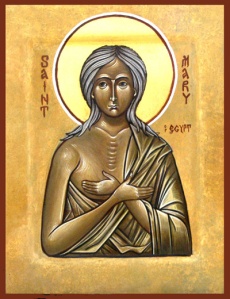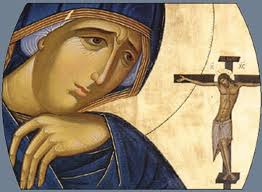By Student Richard Turner
#Legendary #ProstituteSaint

- Born ca. 344, death ca. 421-530 (?)
- St. Mary is respected as the patron saint of penitents.
- Ran away at the age of 12 to Alexandria.
- Spent her life there as a harlot for 17 years.

- She went on an anti-pilgrimage to Jerusalem, paid for her voyage by offering sexual favors.
- Denied into the Church of the Holy Sepulchre, because of this she prayed to the icon of Theotokos for forgiveness and stated that she will become abstinent.
- Escaped to desert and lived her life of abstinence, surviving on 3 loaves of bread. She was tempted by wild-beast and passions but Theotokos guided her.

Theotokos (The virgin Mary) - Near death she met. St. Zosimas of Palestine. She narrated her story to him.
- Asked him of holy communion, and he did.
- She told Zosimas to meet her the following lent in the same spot and he did, but when he got there she was lying there dead, but written in the sand was that she had died the night he gave her communion and her body was transported there.
- Her story has been down orally to most orthodox and was first recorded in written word in a vita by St. Sophronius.
Others like her:
Mary the niece of Abraham (St. Mary)
Website of the St. Mary of Egypt Orthodox church
Their website has many neat components.
- Scripture blog post once a month
- Their mission statement
- Daily calendar with lessons
- Holy week services
- 2 audio files: “Life of Holy mother Mary of Egypt” and “St. Mary of Egypt and the Grace of the Holy Mysteries by Fr. Dn. Matthew Steenberg” An orthodox point of views/summaries about St. Mary of Egypt’s life.
Sample of their summary
“St. Mary of Egypt was a young woman who followed the passions of the body, running away from her parents at age twelve for Alexandria. There she lived as a harlot for seventeen years, refusing money from the men that she copulated with, instead living by begging and spinning flax” (St. Mary of Egypt Orthodox church).
Poem about St. Mary of Egypt by Fanny Howe
The rest of this poem can be found at JSTOR
The poem is a summary about St. Mary’s journey as a prostitute. The fact that Fanny chose to write about Mary’s life in a poetic form is ironic because poetry is typically seen as higher class and prostitution is low. However, the fact that Mary becomes a saint could be the reason why Fanny chose poetry instead of another form of literature.
More works by Fanny Howe
Painting by Emil Nolde

This painting is Nolde’s depiction of how it was like for Mary on her anti-pilgrimage to Jerusalem. Notice how the men flock towards her in urge for sexual favors. She seems very passionate to do favors for them.
Youtube
This 3 minute clip/ movie that reenacts St. Mary’s journey as a prostitute.
One commentator says, “Thank you very much for this clip. Today is the fifth Sunday in Lent, so may Saint Mary of Egypt by the divine power that she has earned from God help you in your needs. It’s amazing how the worst sinners have become God’s most precious saints. How can they love God so much? How can they abandon those “delicious” sins and live a continuous prayer disregarding everything wordly? The most lustful woman of Alexandria has become a most amazing saint. Food for thought..”
Here is a long movie with English subtitles about her life.
- Many orthodox churches celebrate her story during lent.
Sieger, William. “Emil Nolde’s ‘Legend: St. Mary of Egypt’: ‘ Vita Activa’/ ‘Vita Contemplativa’.” The Burlington Magazine Vol. 147. No. 1223 (2005): 100-107. Web.

You must be logged in to post a comment.